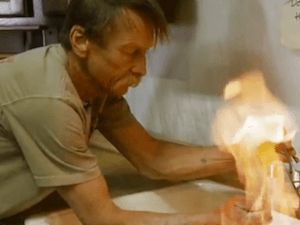Burning water, contamination and natural gas “fracking”
Screenshot from the film Gasland
This blog post originally appeared on TheWorld.org.
A couple of weeks ago PRI’s The World reported on the relatively quiet arrival in Poland of shale gas fracking — that’s shorthand for a new type of natural gas and oil extraction known as hydraulic fracturing. The technology has been producing increasing amounts of natural gas — and controversy — here in the US and is starting to generate opposition elsewhere as it spreads around the world. So far in Poland, though, the only opponents seem to be neighbors of drilling wells. Environmental groups like Greenpeace Poland are reserving judgment, and the government is eager to develop domestic gas supplies that could help free the country from reliance on Russian gas.
The biggest criticism of fracking here in the US is that it contaminates ground water. Greens and local activists say both the chemicals used to help access the gas and the gas itself are leaching into local water supplies, posing both immediate safety and long-term health risks. In a particularly dramatic scene from the 2010 Oscar-nominated anti-fracking documentary “Gasland,” a neighbor of one fracking operation contends that his water supply has been contaminated by methane and proceeds to light the water flowing from his kitchen tap on fire.
The gas industry has vehemently denied such charges. They’ve questioned the veracity of the flaming faucet scene, but have also said that even if it’s real, the flammable water problem could have been due to a broken gas line or other causes unrelated to fracking, and that there’s no mechanism for either gas or fracking chemicals to get from the deep shale rock to the much shallower water tables.
Well, a new peer-reviewed study published this week in the Proceedings of the National Academy of Sciences provides strong evidence that the flaming faucet phenomenon is real.
The study by scientists at Duke University found high levels of methane in drinking water wells within a kilometer of gas wells in Pennsylvania and New York, compared with water supplies up to three km away. On average, the report says, methane concentrations were 17 times higher in water supplies near fracking operations, and “within the defined action level… for hazard mitigation recommended by the US Office of the Interior.” The authors point out that while “dissolved methane in drinking water is not currently classified as a health hazard for ingestion, it is an asphyxiant in enclosed spaces and an explosion and fire hazard.”
The researchers also found telltale chemical markers indicating the gas was in fact from the deep shale reservoirs targeted by the fracking operations and not from sources closer to the surface.
The authors say their results “suggest important environmental risks accompanying shale-gas exploration worldwide.”
Interestingly, the researchers did not find any traces of fracking chemicals in these water supplies. That suggests to them that the gas is leaching not from the fracking process itself but either from disturbances in rock formations between the deep shale and the shallow aquifers, or from the gas wells themselves.
So–after years of growing dispute, journalistic examination and government inquiry, this first peer-reviewed study of the impact of fracking on groundwater essentially splits the difference between opponents and supporters. It links fracking to serious contamination of drinking water with methane, but not with other hazardous chemicals.
The authors call for more research to further inform the public debate. And for now, that debate is sure to heat up. Maybe even in Poland.
You can watch a trailer for Gasland below:
——————————————————————————-
PRI’s “The World” is a one-hour, weekday radio news magazine offering a mix of news, features, interviews, and music from around the globe. “The World” is a co-production of the BBC World Service, PRI and WGBH Boston. More about The World.
